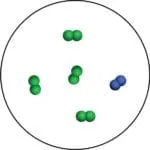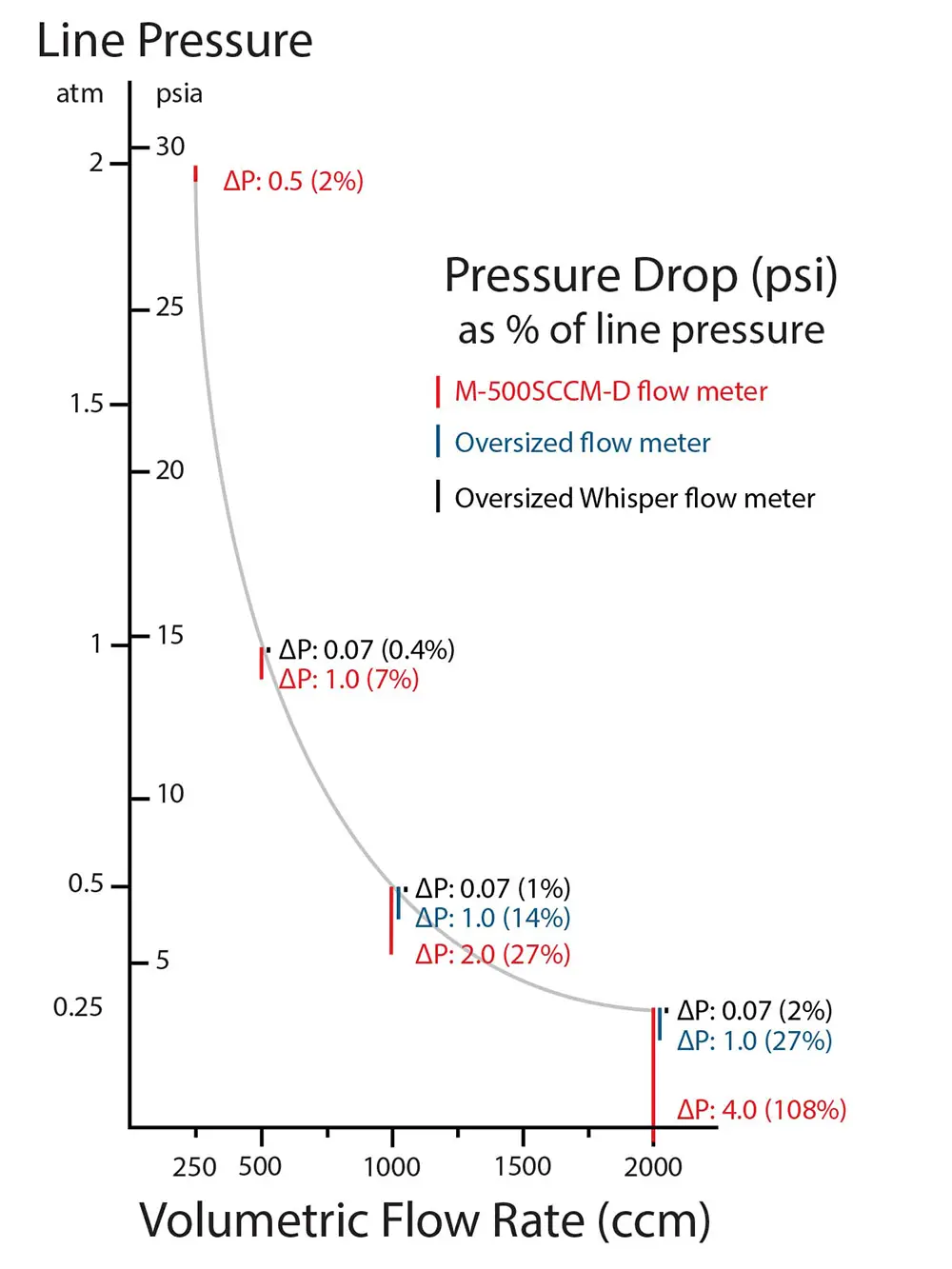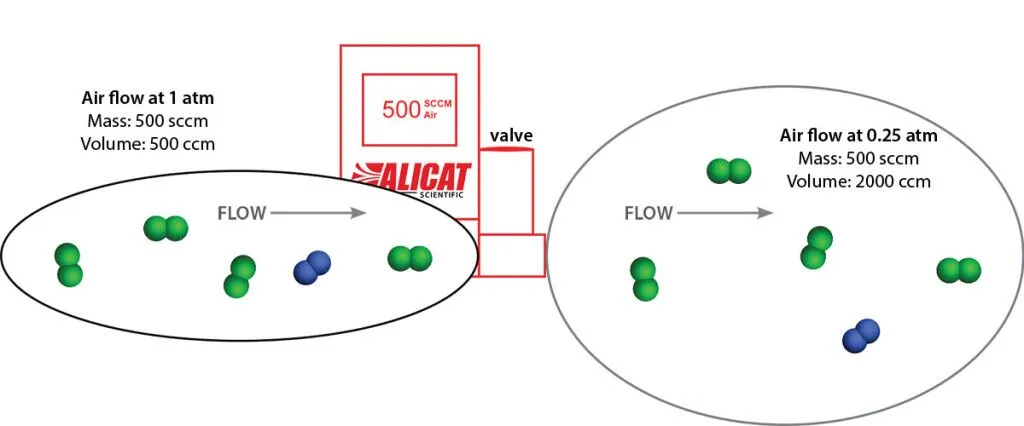Measuring flow at subatmospheric pressures
Measuring flow below atmospheric pressure can be challenging due to changing volumetric flow rates and pressure drop requirements. It is critical to consider operating conditions and device capabilities to ensure your flow meter gives correct readings.
In this article, we will discuss the relationship between line pressure, flow rate, and pressure drop to determine the best mass flow solution for applications operating below atmospheric pressure.
How does line pressure affect volumetric flow rate?
Gases are compressible, and the behavior of gas molecules is described using the ideal gas law (PV=nRT). Imagine a closed volume with a fixed amount of gas molecules (n) and a constant temperature (T). Pressure and volume are inversely proportional, so increasing pressure will lead to a decrease in volume and vice versa.
Consider filling a flexible, non-elastic balloon with 500 SCM3 of air at atmospheric pressure (1 atm, about 14.696 PSIA) and standard ambient temperature (25°C). Doubling pressure to 2 atm compresses the gas and results in a balloon volume of 250 CM3, and reducing pressure by 1/4 to 0.25 atm expands the gas leading to a volume of 2000 CM3.
Air at 1 atm
Mass: 500 SCM3
Volume: 500 CM3
Air at 2 atm
Mass: 500 SCM3
Volume: 250 CM3
Air at 0.25 atm
Mass: 500 SCM3
Volume: 2000 CM3
This concept is the same for flowing gases, and decreasing line pressure increases the volumetric flow rate.
How does line pressure affect pressure drop?
Line pressure isn’t constant across an entire flow path. Pressure is lost due to frictional resistance in the flow path caused by valves, fittings, and tubing. This pressure loss is referred to as pressure drop, and decreasing line pressure leads to an increase in pressure drop.
Choosing a flow meter for applications operating at subatmospheric pressure
With these two considerations in mind, decreasing line pressure increases both volumetric flow rate and pressure drop. When flowing gas below atmospheric pressure, the associated high volumetric flow rates and pressure drops are important considerations for device sizing.
Laminar DP mass flow meters have internal flow channels that are sized for the highest volumetric flow rates that are expected to pass through them. When these meters are used in subatmospheric applications, they may need to be oversized in order to handle the increased volumetric flow rates.
Ranging a meter to flow 500 SCCM of air at 0.25, 0.5, 1, and 2 atm
Imagine you order an Alicat laminar DP mass flow meter built to flow 500 SCCM (SCM3/min) of air at full scale at 1 atm.
- 2 atm: If you use this device to flow 500 SCCM of air at double the pressure (2 atm), the volumetric flow rate decreases to 250 CCM. This still falls within the measureable range of the meter.
- 0.5 atm: What happens if you flow the air at 0.5 atm? Decreasing pressure by half doubles the volumetric flow rate to 1000 CCM. This flow rate is too high for a 500 SCCM device, and would instead require a meter ranged to flow 1000 SCCM (1 SLPM) at full scale. To maintain the greatest mass flow measurement resolution, we would specify custom ranges of 500 SCCM (mass flow) and 1000 CCM (volumetric flow).
- 0.25 atm: At 0.25 atm, the meter would be built for four times the intended mass flow, ranged to flow 500 SCCM and 2000 CCM (2 SLPM).
What about pressure drop?
Standard 500 SCCM, 1 SLPM, and 2 SLPM instruments all have full-scale pressure drops of 1 PSID at 1 atm. If you have enough system pressure in your subatmospheric system to lose 1 PSI through the flow meter, any of these can work.
-
-
- 0.5 atm: At 0.5 atm, the pressure drop across the oversized 1 SLPM meter restricts 1 PSID which is around 14% of the available system pressure.
- 0.25 atm: It gets even tighter working at 0.25 atm, where the oversized 2 SLPM meter again induces 1 PSID of pressure drop. This means 27% of the available pressure is now lost, which can be problematic when system pressure is limited.
-
Using a low pressure drop flow meter for subatmospheric pressure
Whisper low pressure drop mass flow meters have much lower pressure drops than our standard meters, making them ideal solutions for applications operating at subatmospheric pressure. An oversized 1 SLPM Whisper meter has a pressure drop of only 0.07 PSID at 0.5 atm and 500 SCCM, which is just 1% of the available system pressure.
Both the standard mass flow meter and the Whisper meter perform with the same accuracy under these conditions, but using a low pressure drop meter minimizes pressure loss and gives more freedom to design subatmospheric systems.
Generally speaking, Alicat mass flow meters can be used down to 0.8 atm/11.5 PSIA without being oversized. We can oversize flow meters for use at pressures as low as 0.2 atm/2.9 PSIA.
Sizing flow controllers for vacuum and subatmospheric pressure
Unlike meters, differential pressure-based mass flow controllers do not always need to be oversized for use in subatmospheric conditions. For these applications, we locate the proportional control valve at the downstream side of the controller. This forms a sonic barrier that shields the flow sensor from the volumetric expansion of the gas. In cases where the controller cannot be configured with a downstream valve and the measurement element is exposed to subatmospheric conditions, oversizing may still be required.
In the example below, the measurement head inside the flow controller always sees flow rates at ambient air pressure (1 atm). The gas enters the subatmospheric condition (0.25 atm) and expands only after it passes through the valve. As in the previous examples, the mass flow rate remains constant as the gas transitions from 1 atm to 0.25 atm.




